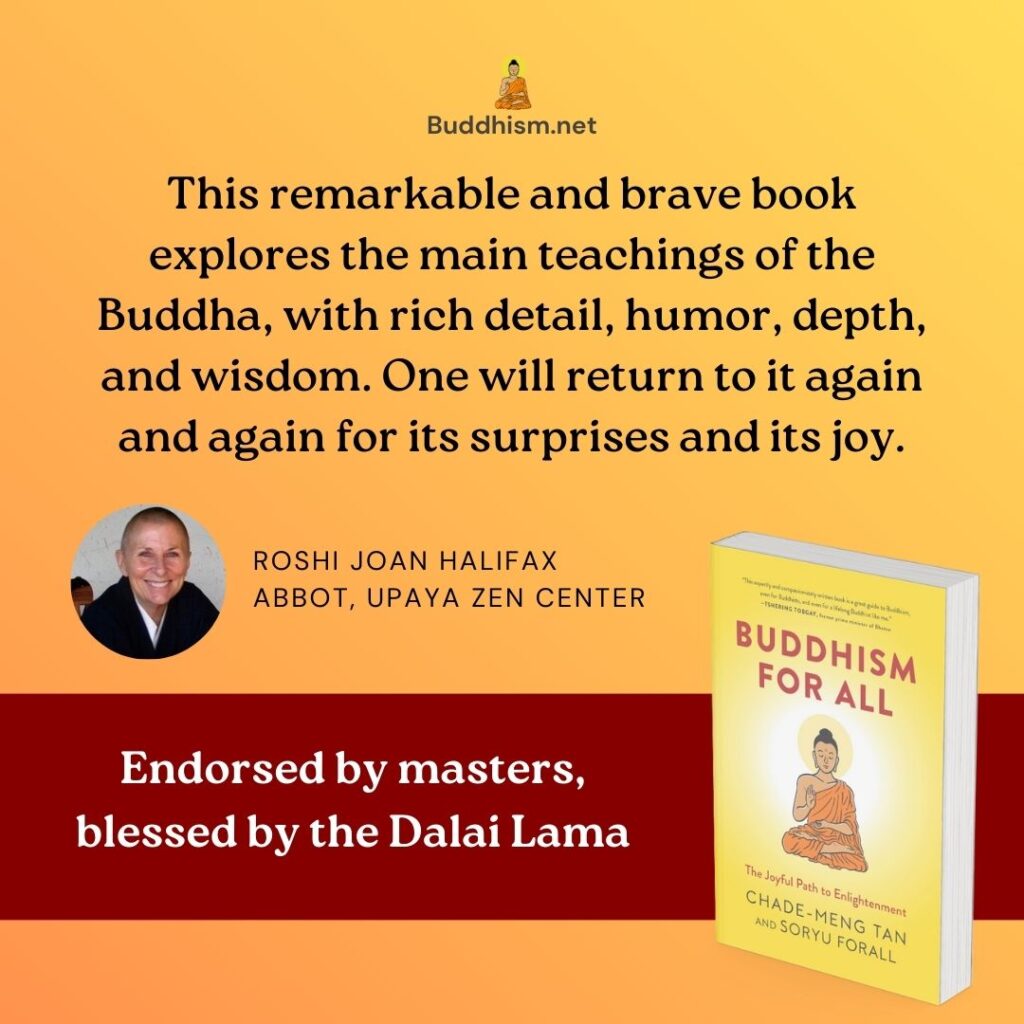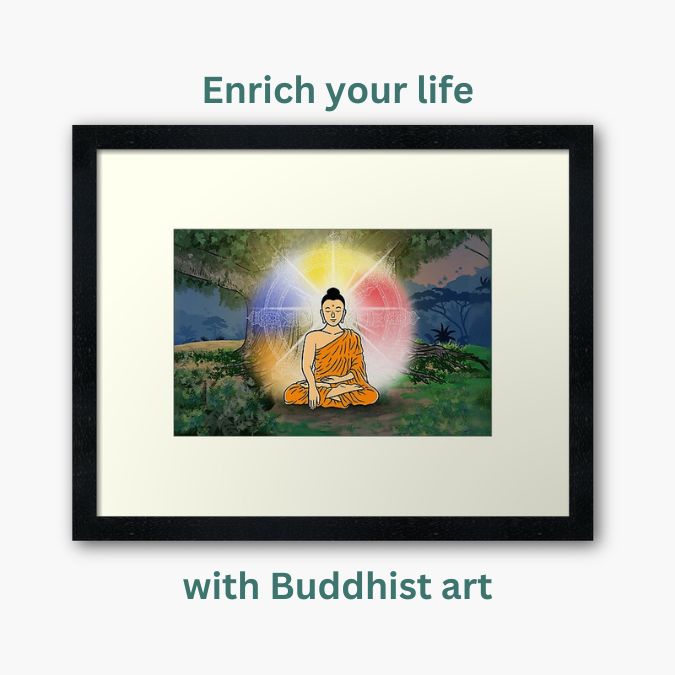
“I pray that we are not a religion.”
Is Buddhism a religion? Is it, instead, a philosophy? First, let’s see what the Buddha himself has to say. It turns out, he has an answer for that question. He says emphatically, “What I teach is suffering and the cessation of suffering.”[1]
The Buddha was in Kosambi taking a walk with the monks in the forest. He held up a handful of leaves and asked the monks, “Which is more, the leaves in my hand or all the leaves on all the trees in this forest?” “The leaves on the trees, Venerable Sir.” “In the same way, the leaves on the trees represent all that I have directly known, the leaves in my hand represent what I teach.”[2] The Buddha then went on to say he only taught those teachings that lead to liberation from suffering, which is only a tiny subset of what he had directly known. That tiny subset is centered around the Four Noble Truths. This discourse is the reason the Buddha’s teachings is sometimes poetically referred to as “a handful of leaves”.
In that sense, Buddhism is not a religion. It is not even a philosophy. It is simply a collection of profound teachings and practices leading to liberation from suffering. More than that, as you have seen in this book, all the practices taught by the Buddha are extremely secular. In addition, if we define religion as the belief in and worship of one or more gods[3], we can argue that there is no such thing as a religion where no god is worshiped. I mean, it is kind of absurd, right? Which major religion do you know has zero worship of any god and does not even give a damn about miracles? In that sense, Buddhism, at least early Buddhism, is not a religion.
But not so fast! Even if Buddhism is not a religious tradition, it is most definitely a spiritual tradition. It deals with essential spiritual matters such as death, the afterlife and deathlessness (the transcending of death). At what point does such a spiritual tradition become a religion, or not a religion? There is no consensus on where to draw the line. Some people call Buddhism a “non-theistic religion”, while some call it “spirituality, not religion”.
But wait, there’s more. As time went on, Buddhism took on the function and trappings of religion. In some cultures, it functions like a religion, especially in ceremonies involving say marriages, funerals, and coronations of kings. Also, over time, a pantheon of gods started getting added to Buddhism. There is, for example, the character of Amitabha Buddha whose name you can chant, and if you can recite his name in perfect mindfulness ten times as you are dying, you can be reborn in his “Pure Land”.[4] There is the ever-popular Guan Yin, the Bodhisattva of Compassion; there is Maitreya, the upcoming Buddha; there is Manjusri, the Bodhisattva of Wisdom; and there is Brahmā, recast as the “Four Faced Buddha”. Each one is an inspiring symbol, and a useful aid for one’s meditation practice. And of course, in folk Buddhism, each one, plus the Buddha, also serves as a god that people can (and do) worship and ask divine favors from.
When I was growing up in Singapore, all the adults I knew went to the temple periodically to beg those “Buddhist gods” for winning lottery numbers, and lo and behold, in an awesome demonstration of their divine glory, the Buddhist gods actually granted winning numbers, at roughly a rate predicted by statistical probability. In that sense, yes, later Buddhism has definitely become a religion.
It is not just gods, miracles also started gaining a more prominent place in later Buddhism as well. Tibetan Buddhism, for example, is chock full of stories about miracles. Tibetan Buddhism includes deeply scholastic traditions in which the systematic study and the extensive monastic curriculum in logic and epistemology can take decades to cover. At the same time, it also has an amazingly well-developed mystical side. Some of the most fascinating examples for me involve the Karmapas. The original Karmapa was a great Tibetan Buddhist master who lived from 1110 to 1193 CE. The Second Karmapa was the teacher of Kublai Khan, Emperor of the Mongolian empire at its height, and the most powerful man in the world. Kublai held a grudge against the Karmapa for a perceived snub, so after he became the emperor, he sent a small army to capture or kill the Karmapa, but the Karmapa got free every time, including at one time, freezing the entire army in place. Kublai was so impressed that he eventually asked the Karmapa to be his teacher. After the Second Karmapa, a few subsequent Karmapas were also teachers of emperors and were also known to possess psychic powers.

The Sixteenth Karmapa passed away in 1981, so he was a modern-day lama with American students, some of whom I personally know, and they tell me they witnessed that Karmapa perform miracles. For example, one time, when the Karmapa was meditating with his students, his body became translucent. One Western student took a picture. I’ve seen the photo and I’m really not sure what to make of it (yes, his body did look translucent, as in you can see some of the things behind him). I’m quite fascinated, though.

You may wonder why there is a line of Karmapas. That is a unique feature of Tibetan Buddhism. The word Karmapa literally means “action doer”, or one who performs actions (on behalf of the Buddha), so unsurprisingly, the (original) Karmapa decided he wanted to continue staying in the world to serve all sentient beings even after he died. As he was passing away, he left a letter to his main disciple on how to find his upcoming reincarnation. His disciple did, and the little boy identified as his reincarnation was installed as the Second Karmapa. That tradition continues to this day: every time a Karmapa dies, his top disciples identify and install his supposed reincarnation as the next Karmapa. This is called the “tulku” system, a tulku being a reincarnate custodian of a lineage. This system has been applied to many other great Tibetan masters, most famously the Dalai Lama. (If you ask me, I think the tulku system has outlived its usefulness and it’s time for it to be retired.)
The practices in Buddhism also became increasingly mystical and religious over time. In early Buddhism, the practices were extremely secular. In contrast, for example, in a later form of Buddhism called Pure Land Buddhism, the main practice (or the sole practice, depending on which teacher you ask) involves having complete faith in a buddha known as Amitabha Buddha, and chanting his name frequently. That clearly crosses the boundary into “religion”. One of the most important features of Pure Land Buddhism is you need to be able to chant Amitabha’s name in perfect mindfulness as you lay dying, and in order to be able to do that, you need to train yourself to develop a very high degree of mindfulness and samadhi in your regular practice using devotion to Amitabha (or the sound of Amitabha’s name, depending on the teacher) as the meditation object. So, clearly, this almost certainly started as a compassionate way to help the large uneducated lay populace of ancient times practice mindfulness and samadhi (remembering that very few people in ancient times had the opportunity to receive formal education), but it is also religious in its framing. That is not to say that Pure Land Buddhism isn’t Dharma, of course it is still Dharma. Remember that Dharma is defined as universal law pertaining to suffering and liberation from suffering. Wherever there is an understanding of suffering and liberation from suffering, there is Dharma. Pure Land Buddhism is Dharma delivered in a religious packaging for those inclined to practicing it that way.
In Vajrayana Buddhism, which includes Tibetan Buddhism, practices got even more mystical and religious, involving energy, chakras, tantras, gods, tulkus, and secret teachings that can only be revealed by masters to a select few. In fact, Vajrayana Buddhism is so mystical its Chinese name is mizong (密宗), which literally means the “mystical tradition”. This has, of course, come a long, long way from the original flavor of early Buddhism, where the Buddha said he did not have “the closed fist of a teacher”,[5] which means that he had no secret teachings: everything he taught was in the open for all to clearly see. Vajrayana Buddhism is still Dharma, no doubt, but the same wonderful medicine has now acquired a very different flavor. Early Buddhism is like clear miso soup, subtly tasteful and refreshing, while Vajrayana Buddhism is like spicy curry, packing a wallop of aroma and flavor. Both are delicious, in different ways. They can even be consumed together, I do that myself (for both soup and Dharma).
So, is Buddhism a religion or not? I would say at its core, Buddhism is not a religion, it is a set of profound teachings and highly secular practices leading to liberation from suffering. However, Buddhism comes with an option that can be exercised to turn it into a religion, and societies and individuals are all free to exercise that option. Where and when that option is exercised, Buddhism becomes a religion.
Is a Transformer a car or a fighter robot? It is either one that can be easily transformed into the other depending on whether you need to drive to college or defeat evil killer robots. In the same way, Buddhism can be a religion or a non-religion, and can be easily transformed from one to the other, depending on which one best serves the people. Just like Transformers, Buddhism more than meets the eye.
I’m going to give Soryu the last word on this topic, because I think he says it best:
The Buddha did not teach us that we must worship deities, but he also did not teach us that we must not worship deities. Because a Buddhist is not required to worship deities, Buddhism is secular. At the same time, because a Buddhist is allowed to worship deities, Buddhism may be religious. In any case, the core of Buddhism is our own path to liberation from suffering. This is a path of our own direct experience. We must walk this path ourselves. No one else can walk it for us. Not deities. Not even the Buddha.
Activities:
- Reflect on this post with Angela:
- Just as there are different cuisines which appeal to different palates, Buddhism has myriad forms, due to its transmission to different cultures. It is beautiful that we have access to various expressions of Buddhism.
- It would be a waste if amongst the 84000 methods and practices of Buddhism, you cannot find one that resonates with you. Do you prefer the science-based approach? Are you suffering deeply and want to be relieved of suffering? Or does cultivating universal immeasurable compassion resonate more with you? Do you prefer a daily meditation practice to settle and refresh your mind? Or do you prefer to cultivate good karma and merits by doing good, and practicing generosity? Are you someone with a high level of discipline and can commit to keep the 5 precepts for life? Or are you more devotional in nature? These practices are not mutually exclusive. Find what works for you
- What stood out to you from this article? Why?
References:
[1] Majjhima Nikāya 32.
[2] Saṃyutta Nikāya 56.31.
[3] As defined in the Merriam-Webster Dictionary, and others.
[4] Amitāyurdhyāna Sūtra (佛说观无量寿佛经). The specific phrase, instructed to one on the eve of death: “With your full heart, with a voice uninterrupted, complete ten recitations of Namo Amitabha Buddha.” (如是至心,令声不绝,具足十念,称南无阿弥陀佛).
[5] Dīgha Nikāya 16.
Artwork by Colin Goh.


